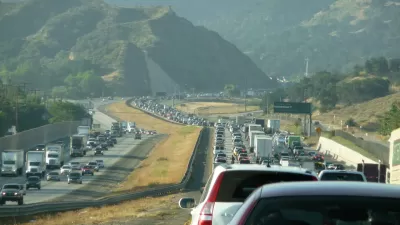A follow-up initiative to Proposition 6 would put the brakes on high-speed rail in California and funnel gas tax funds to roads.

Rachel Swan reports on a recently-filed California ballot measure that would stop the state's high-speed rail project from moving forward and prevent it from using gas-tax funds for public transit. This challenge comes from supporters of Proposition 6, an upcoming California ballot measure that would repeal the gas tax passed last year.
In addition to killing [Jerry] Brown's $77 billion plan to send bullet trains zipping from Southern California to downtown San Francisco, the initiative that [Carl] DeMaio and others submitted on Tuesday would mandate that all gas tax revenue go to roads. It would also dedicate the state's sales tax on cars to all forms of transportation infrastructure including public transit, require annual audits on road projects and shift decision-making power on gas and car tax revenue from the state Capitol to city and county governments.
Supporters of this new measure say that state funds for roads would increase by $2.7 billion and for transit infrastructure by $5.6 billion. Critics argue that the initiative is not much different than an alternative to the gas tax measure that Republicans put forth last year. "Other lawmakers rejected the plan because it blocked gas tax money from flowing into the general fund, where it helps shore up schools, health care and public safety," says Swan.
John Cox, the Republican candidate for governor, supports the effort to end the high-speed rail project. With high-speed rail as a central issue for Republican voters, who favor road and highway projects, the proposed measure is also seen as a way to get those voters to the polls and to increase support for Cox.
FULL STORY: Gas-tax opponents file proposal to kill $77 billion high-speed train

Planetizen Federal Action Tracker
A weekly monitor of how Trump’s orders and actions are impacting planners and planning in America.

Maui's Vacation Rental Debate Turns Ugly
Verbal attacks, misinformation campaigns and fistfights plague a high-stakes debate to convert thousands of vacation rentals into long-term housing.

San Francisco Suspends Traffic Calming Amidst Record Deaths
Citing “a challenging fiscal landscape,” the city will cease the program on the heels of 42 traffic deaths, including 24 pedestrians.

Defunct Pittsburgh Power Plant to Become Residential Tower
A decommissioned steam heat plant will be redeveloped into almost 100 affordable housing units.

Trump Prompts Restructuring of Transportation Research Board in “Unprecedented Overreach”
The TRB has eliminated more than half of its committees including those focused on climate, equity, and cities.

Amtrak Rolls Out New Orleans to Alabama “Mardi Gras” Train
The new service will operate morning and evening departures between Mobile and New Orleans.
Urban Design for Planners 1: Software Tools
This six-course series explores essential urban design concepts using open source software and equips planners with the tools they need to participate fully in the urban design process.
Planning for Universal Design
Learn the tools for implementing Universal Design in planning regulations.
Heyer Gruel & Associates PA
JM Goldson LLC
Custer County Colorado
City of Camden Redevelopment Agency
City of Astoria
Transportation Research & Education Center (TREC) at Portland State University
Jefferson Parish Government
Camden Redevelopment Agency
City of Claremont





























